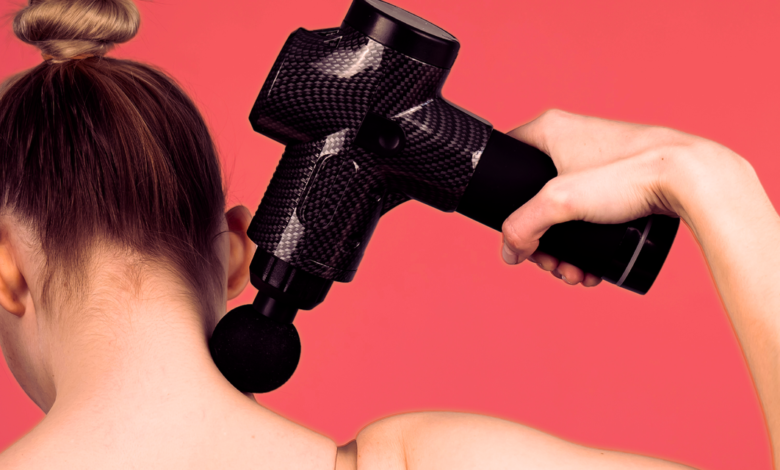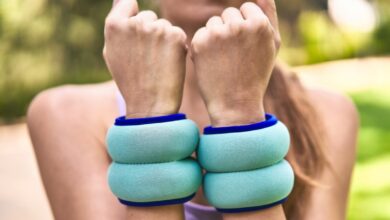Why You Really, Really Shouldn’t Use a Massage Gun on Your Neck

A fitness TikToker is warning people about an unsettling experience she had after using a massage gun on her neck. In the video, which has racked up 4.6 million views so far, Sophie Dolce explained that she recently woke up with “the worst kink in her neck.” So she turned to her massage gun for some relief, noting that she targeted her neck, the base of her skull, shoulder, and back. On that day, Dolce used the massager frequently—on a high setting, every 30 minutes between 8 a.m. and 5 p.m.—because it “temporarily” helped ease her pain.
“I ended up getting super sore, red, inflamed…all over where I was using it,” Dolce said in the video. She ended up feeling worse and had trouble sleeping that night because she was “in so much pain.” When she woke up in the morning, the pain had persisted and she felt an unusual lump on her neck. A spurt of panicked googling prompted her to see a doctor immediately. “My doctor was like, ‘Don’t you dare ever use a massage gun on your neck,’” she said, adding that she was warned this can mess with the blood flow in the area that leads to the brain.
“I originally shared [the video] to spread awareness to anyone who may have done or might be planning on doing the same thing,” Dolce, who creates videos to help others find joy in movement, tells SELF. She said the lump might be due to an inflamed lymph node because she used the device so much, but she’s getting some testing done to be sure.
Lots of people rely on a massage gun to alleviate muscle soreness, tension, and pain—so we asked experts about Dolce’s PSA, and they said she’s right to call attention to it.
Why you shouldn’t use a massage gun directly on your neck
Several people in the comments of Dolce’s post said either they or a loved one had experienced a stroke or seizure after using a massage gun on their neck—and this is, in fact, a risk. As Dolce mentioned in her video, there is a pair of carotid arteries on each side of your neck, which have the very important job of moving oxygen-rich blood from your heart to your brain and the rest of your head.
“You do not want to use percussive therapy—a massage gun—over an artery,” Ryan Krzyzanowicz, DAT, the director of athletic training education at the University at Buffalo in New York, tells SELF. Percussive devices generally deliver “rapid pulses in short bursts of pressure” straight into your tissues, as one paper puts it. So when you’re using one right on your neck, “we get worried about blood flow to the brain. In theory, percussion could temporarily starve the brain from blood flow, causing a mini stroke or stroke-like symptoms.” (This could include sudden confusion or trouble speaking, numbness or weakness on one side of the body, a quick-hitting and severe headache, and trouble walking or seeing, among other things.)
Neel Anand, MD, a board-certified orthopedic surgeon and codirector of spine trauma at Cedars-Sinai Spine Center in Los Angeles, agrees. “A massage gun should not be used on the front or side of the neck,” he tells SELF. “You could displace the carotid artery and get a stroke.”
A 2022 case report published in the journal CPC Emergency Medicine details the story of a 27-year-old woman who developed vertebral artery dissection—a potential cause of stroke—after using a handheld massage gun on her neck for at least three weeks. The woman, who went to the emergency room after developing headaches, neck pain, and “progressively worsening” dizziness, needed treatment but eventually recovered.
It’s also possible that using a massage gun on your neck could irritate the lymph nodes—bean-shaped, infection-fighting glands—in the area too. “It happens due to the percussive nature of the massage gun hitting the lymph node, causing inflammation,” Krzyzanowicz explains. This can trigger a lump to form; Krzyzanowicz compares it to the swelling you’d likely experience after, say, spraining your ankle.
Are there other areas of your body you should avoid?
Dr. Anand says it’s generally safe to use a massage gun on the shoulder muscles that lead up to your neck—just not the neck itself. But if you use a massage gun regularly, it’s best to get a doctor or physical therapist’s input on where and how often you should use it—especially if you’re nurturing an injury, bruise easily or have a bleeding disorder, have a chronic condition, or deal with a persistently painful problem area.
In addition to your neck, Krzyzanowicz recommends avoiding the area around and over your eyes, over your heart, in and around your inner groin, directly behind your knees, particularly bony areas, and any spots where you might not have the same level of feeling you normally do. “Let’s say you just had surgery and are numb in a body part—it’s not wise to use a massage gun on that body part because you can’t feel what is going on,” Krzyzanowicz says.
Here’s a general rule from Dr. Anand: “Use the massage gun on areas that are solid muscle—like your back or the main muscles in your legs and arms. You shouldn’t be using it in a soft area.”
If you wind up with significant bruising, your body feels much worse, or whatever device you have just isn’t working for you—it’s best to pause altogether and talk to a pro about what’s going on and if you should look into other methods for relief.
This article was updated on 1/26/24 to reflect Dolce’s response to our request for comment.
Related:



